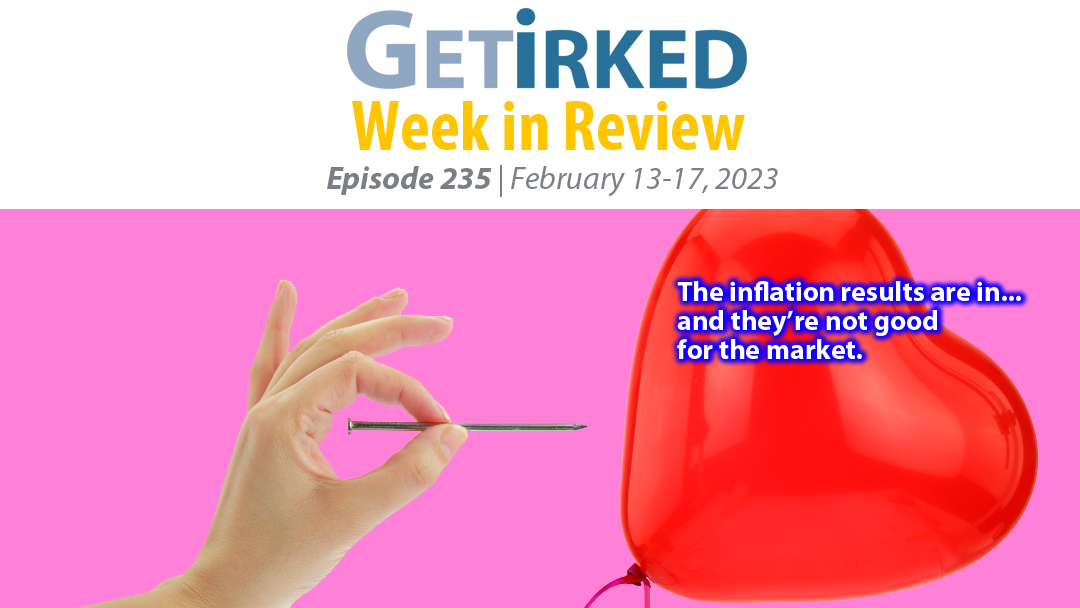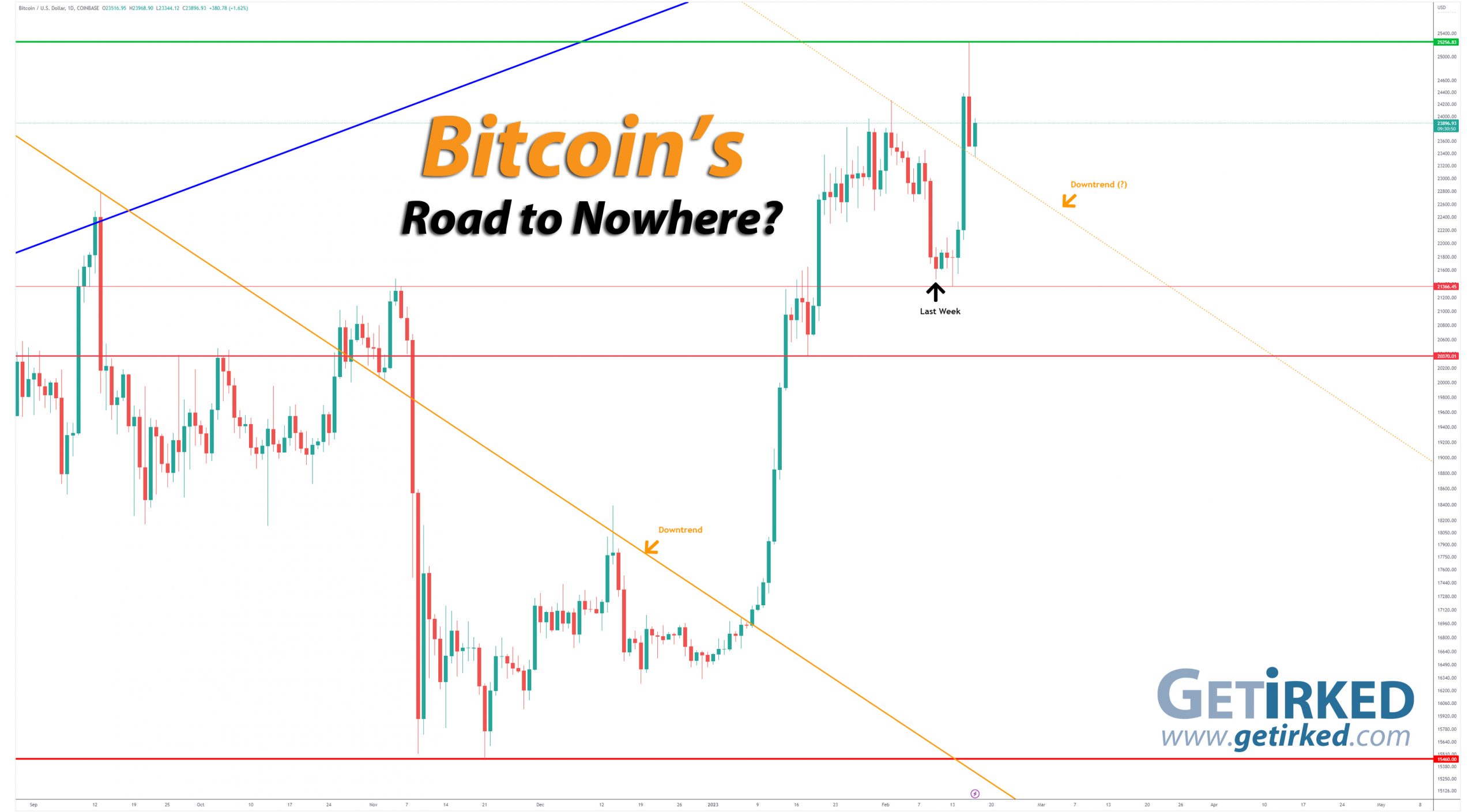Summing Up The Week
The economy received its inflation “report card” this week in the form of a variety of indicators, and the grades were not good. Inflation is still running rampant everywhere.
Accordingly, the markets finally gave up some of the bull rally as investors realized the Federal Reserve will actually have to do what it’s been saying it would – keep rates higher for longer.
Let’s look at the news that moved the markets this week…
Market News
Inflation warning from Inventory Glut
Before the CPI report even dropped on Tuesday, warehouse and distribution centers released a report showing U.S. storage prices rising 1.4% month-over-month and nearly 11% year-over-year due to an inventory glut, reported CNBC on Monday.
Logistics manager warned of a persistent source of inflation on the supply chain, potentially having a substantial impact on consumer pricing. “In 2022, we saw rate levels for international air and ocean and domestic trucking fall back down to Earth,” said Brian Bourke, global chief commercial officer at SEKO Logistics. “But inflationary pressures remain where demand outpaces supply in 2023, including in warehousing through most of the United States, domestic parcel and labor.”
A potential cause for the issue is a lack of new warehouse facility construction. “National warehousing capacity remains low and will remain tight for the foreseeable future as U.S. industrial construction starts have fallen considerably year-over-year due to rising interest rates,” said Chris Huwaldt, vice president of solutions at WarehouseQuote.
Inflation +6.4% from year ago, more than expected
On Tuesday, the much-anticipated Consumer Price Index showed inflation rose +0.5% in January and was up 6.4% from the same period in 2022, both higher than expected, reported CNBC. After showing signs of receding over the past few months, the index showed increases across shelter, food, and energy.
According to the Bureau of Labor Statistics (BLS), rising shelter costs accounted for about half of the increase with energy also being a significant contributor, up 2% in January and 8.7% on the year.
“Inflation is easing but the path to lower inflation will not likely be smooth,” said Jeffrey Roach, chief economist at LPL Financial. “The Fed will not make decisions based on just one report but clearly the risks are rising that inflation will not cool fast enough for the Fed’s liking.”
While there was much adieu about a change in how the CPI would be calculated – using only the past year of data whereas it had previously used the past two years – the new formula did not appear to affect the report. Despite the anticipation in the markets over the CPI report, stocks did not reach significantly in either direction with the S&P 500 remaining relatively flat after the report’s release.
Retail sales jump +3% in January, despite inflation
On Wednesday, the Commerce Department reported retail sales for January increased 3%, far more than the 1.9% expected, reported CNBC. While a spending U.S. consumer typically indicates a strong economy, the Federal Reserve is actively trying to reduce spending in order to keep inflation in check.
With consumers continuing to spend, the Fed will likely increase interest rates in an effort to reduce spending and increase saving. “I am confident that the gears of monetary policy will continue to move in a way that will bring inflation down to 2%. We will stay the course until our job is done,” New York Fed President John Williams said.
Producer Prices rose 0.7% in January, more than expected
On Thursday, more data showing the Fed might not have inflation licked came in the form of the Producer Price Index (PPI) showing costs for producers rose 0.7% in January, far above estimates of 0.4% from Dow Jones economists, reproted CNBC.
Although the Fed doesn’t use the PPI as its main inflation indicator (it prefers the Personal Consumption Expenditure – PCE), the PPI is often a leading indicator of what we can expect from upcoming data, and this PPI isn’t good.
“My expectation is that we will see a meaningful improvement in inflation this year and further improvement over the following year, with inflation reaching our 2% goal in 2025,” Cleveland Fed President Loretta Mester said in a speech Thursday morning. “But my outlook is contingent on appropriate monetary policy.”
Next Week’s Gameplan
This week’s price action started to show cracks in the bull rally, and all of the euphoric price action we’ve been seeing since the start of 2023 may begin to give way.
Additionally, Michael Gayed (@leadlagreport), the analyst I spoke of last week whose analysis predicted this melt-up, believes we may see the reversal of the price action starting as soon as March.
As always, all of this crazy price action reinforces my key investing discipline: have a plan for what I will do if stocks go up tomorrow and a plan if stocks go down tomorrow.
See you all here next Friday!
This Week in Play
Stay tuned for this week’s episodes of my two portfolios Investments in Play and Speculation in Play coming online later this weekend!
Crytpo Corner
Important Disclaimer
Get Irked contributors are not professional advisers. Discussions of positions should not be taken as recommendations to buy or sell. All investments carry risk and all readers must accept their own risks. Get Irked recommends anyone interested in investing or trading any asset class consult with a professional investment adviser to determine if an investment idea is suitable to them and their investment goals.
Bitcoin Price (in USD)
%
Weekly Change
Bitcoin Price Action
Crypto is the only sector where more regulation is bullish…
Bitcoin is a really weird little beastie. On Wednesday, it rallied epically (nearly +10% in a single day) on the back of news that the SEC had expanded regulations to include cryptocurrency, particularly focusing on the concept of custody (i.e. how a brokerage has to properly secure assets in the names of their users).
In any other asset class, increased regulations would be a bearish sign. However, institutions have been unable to enter the cryptocurrency space due to the lack of regulations, so, as bizarre as it sounds, the SEC announcing a regulatory crackdown on crypto is actually bullish for the space.
On Monday, Bitcoin actually broke through its support before setting a new weekly low at $21,366.45. On Thursday, Bitcoin experienced what some analysts referred to as a “blowoff top,” rocketing to its highest point since August 2022 and setting a new monthly high at $25,256.83 (the previous high had been $25,214.57) before pulling back. You can also see that I’ve added yet another Downtrend (?) trendline, this one potentially indicating that Bitcoin has tested it before moving higher in a bullish move early on Friday.
From here, for the next big move, Bitcoin must either break through its new high or lose support at the low.
The Bullish Case
Bulls continue to assert that this run is for real and that Bitcoin has now entered its next Bull Market Cycle. With the crypto making high after high, the Bulls certainly have the momentum currently.
The Bearish Case
Bears point to the fact that Bitcoin has never existed in a tight-rate environment and that the current run to new highs for the year is only a bear market rally that will end terribly for the bulls. However, given the strength Bitcoin continues to exhibit, the burden of proof remains on the bear case.
Bitcoin Trade Update
Current Allocation: 2.462% (-0.117% since last update)
Current Per-Coin Price: $21,049.85 (-1.490% since last update)
Current Profit/Loss Status: +13.525% (+11.382% since last update)
When Bitcoin rallied unexpectedly on Wednesday following the SEC news about new regulations, I took some more profits with a few sales that went through at an average price of $23,990.02 (after fees).
The small sales lowered my per-share cost -1.490% from $21,368.31 to $21,049.85 and lowered my allocation -0.117% from 2.579% to 2.462%.
Bitcoin Buying Targets
Using Moving Averages and supporting trend-lines as guides, here is my plan for my next ten (10) buying quantities and prices:
0.027% @ $20,459
0.055% @ $20,024
0.137% @ $19,624
0.274% @ $19,127
0.274% @ $18,754
0.412% @ $18,064
0.412% @ $17,733
0.412% @ $17,209
0.549% @ $16,767
0.549% @ $16,367
Not Your Keys, Not Your Crypto…
In light of everything happening with brokerages, I no longer keep any of my crypto on an exchange and I only keep enough USD on the exchange to execute my next few buys. I use multiple cold wallets from the brands Ledger and Trezor to hold my crypto (click the links to access the direct sites, and I receive no affiliate benefits from these links).
Additionally, I have now divided my allocated USD between two different exchanges – Gemini and Coinbase – in case one (or both) becomes insolvent. Disclaimer: We both receive a bonus if you use either my Gemini or Coinbase referral links to open accounts.
Given everything that happened with FTX and Sam Bankman-Fried claiming customer funds were safe only to have it go completely bankrupt, I do not trust anyone in the space, even with Coinbase (COIN) being publicly traded (and one of my own Investments in Play positions).
No price target is unrealistic in the cryptocurrency space – Bullish or Bearish.
While traditional stock market investors and traders may think the price targets in the cryptocurrency space are outlandish due to the incredible spread (possible moves include drops of -90% or more and gains of +1000% or more), Bitcoin has demonstrated that, more than any speculative asset, its price is capable of doing anything.
Here are some of Bitcoin’s price movements over the past couple of years:
- In 2017, Bitcoin rose +2,707% from its January low of $734.64 to make an all-time high of $19,891.99 in December.
- Then, Bitcoin crashed nearly -85% from its high to a December 2018 low of $3128.89.
- In the first half of 2019, Bitcoin rallied +343% to $13,868.44.
- In December 2019, Bitcoin crashed -54% to a low of $6430.00 in December 2019.
- In February 2020, Bitcoin rallied +64% to $10,522.51.
- In March 2020, Bitcoin crashed nearly -63% to a low of $3858.00, mostly in 24 hours.
- Then, Bitcoin rallied +988% to a new all-time high of $41,986.37 in January 2021.
- Later in January, Bitcoin dropped -32% to a low of $28,732.00.
- In February 2021, Bitcoin rallied +103% to a new all-time high of $58,367.00.
- Later in February, Bitcoin dropped -26% to a low of $43,016.00.
- In April 2021, Bitcoin rallied +51% to a new all-time high of $64,896.75.
- In June 2021, Bitcoin crashed -56% to a low of $28,800.00.
- In November 2021, Bitcoin rallied +140% to a new all-time high of $69,000.00.
- In November 2022, Bitcoin crashed -78% to a low of $15,460.00.
Where will Bitcoin go from here? Truly, anything is possible…
What if Bitcoin’s headed to zero?
The only reason I speculate in the cryptocurrency space is I truly believe Bitcoin isn’t headed to zero. I am prepared for that possibility, however, by knowing I could potentially lose all of the capital I’ve allocated to this speculative investment. Professional advisers recommend speculating with no more than 5% of an investor’s overall assets. Personally, I’ve allocated less than that to speculating in crypto. I feel that anyone who doesn’t fully believe in the long-term viability of cryptocurrency would be better served not speculating in the space. On a good day, this asset class isn’t suitable for those with weak stomachs. On volatile days, the sector can induce nausea in the most iron-willed speculator. If a speculator isn’t confident in the space, the moves will cause mistakes to be made.DISCLAIMER: Anyone considering speculating in the crypto sector should only do so with funds they are prepared to lose completely. All interested individuals should consult a professional financial adviser to see if speculation is right for them. No Get Irked contributor is a financial professional of any kind.


